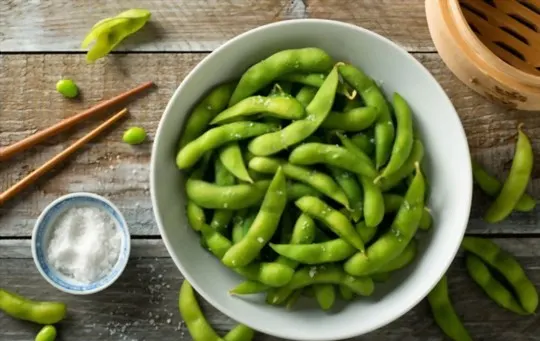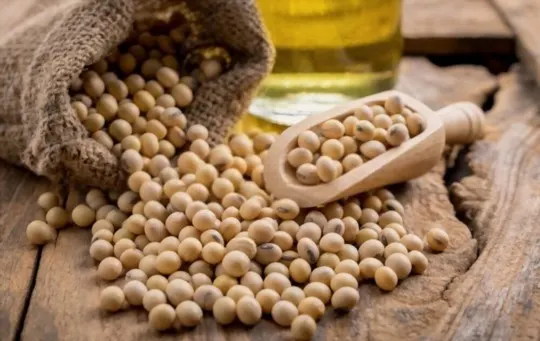Soybeans and edamame seem identical, right? Wrong. We’re here to spill the beans. Literally.
Ever stood in the grocery aisle, scratching your head? We’ve been there.
Soybeans are the big boss, the mature ones in the pod. Edamame? They’re just soybeans living their best, youthful life.
Why does this matter, you ask? Pull up a chair.
Nutrition-wise, they’re powerhouses. Different stages, different benefits.
We’ve crunched the numbers, so you don’t have to. Sit tight, we’re diving deep.
What are Soybeans?

Soybeans are a legume that originated in East Asia and have been consumed as a staple food for thousands of years.
They are rich in protein, fiber, vitamins, and minerals, making them a valuable source of nutrition for vegetarians and meat-eaters alike.
Soybeans come in many different varieties, including black soybeans, yellow soybeans, and green soybeans.
They can be consumed in various forms such as tofu, tempeh, soy milk, and edamame.
Soybeans are commonly used to produce oil and other products such as biodiesel fuel.
The demand for soy products has increased over the years due to their health benefits and versatility in cooking.
Understanding the differences between soybeans and edamame can help individuals make informed choices about their diet and lifestyle.
What is Edamame?

Edamame is a type of immature soybean often served as a snack or appetizer.
These bright green pods are usually boiled or steamed and lightly salted before consumption.
They are popular in many Asian cuisines and offer several nutritional benefits.
Edamame provides a rich source of protein, fiber, vitamins, and minerals, making it an excellent addition to any balanced diet.
The high protein content in edamame is especially beneficial for vegetarians and vegans looking to meet their daily protein requirements.
Differences Between Soybeans and Edamame

Soybeans and edamame are often used interchangeably.
However, they share fundamental differences in how they are consumed.
While both come from the same legume family, soybeans have hard skins and are usually processed before consumption.
In contrast, edamame is a young soybean harvested early, while still green and in its pod.
Edamame can be boiled or steamed and eaten as a snack or added to salads for an aesthetically pleasing crunch.
Origin and Cultivation
Soybeans are a type of legume that originates from East Asia.
They are one of the world’s most important crops and have been cultivated for thousands of years.
The cultivation of soybeans is prevalent in many regions across the globe due to its numerous applications.
These include animal feed, biodiesel, and human consumption.
Edamame refers to immature soybeans still present in their pods.
The term “edamame” originated from Japanese, meaning “branches beans.
” The first instances of edamame consumption were noted in Japan and China around 200 BC.
Like soybeans, edamame has high nutritional value and is beneficial for people who follow plant-based diets.
Interestingly, compared to mature soybeans where the pods harden and dry out, edamame maintains its pod-like texture until just prior to consumption.
Due to this difference in structure, edamame requires a different processing method compared to mature soybeans.
Harvesting and Preparation
Soybeans are typically harvested when they have matured and dried up, and they are mainly used for oil production, animal feed, and tofu.
Edamame, on the other hand, is harvested when the soybeans are still in their pods while they are still green.
This also means that edamame has a higher moisture content as compared to soybeans.
Both types require boiling or cooking before consumption to soften them up.
Appearance and Texture
The characteristics of Soybeans and Edamame differ in both appearance and texture.
While Soybeans are small, oval-shaped beans with a smooth outer layer, Edamame is green-shaded pods that appear more extensive due to the presence of immature Soybeans inside.
The texture of Soybeans is relatively firmer than that of Edamame due to the maturity level and processing methods used for the two beans.
Soybeans undergo multiple processing stages before they reach consumers, such as boiling, roasting, and grinding into soy milk or oil.
In contrast, Edamame is harvested at an early stage when the seeds are still soft and have not turned brown yet.
The immature state makes Edamame tenderer than mature Soybeans, usually boiled or steamed before consumption.
Apart from their difference in appearance and texture basis their harvesting stage, the nutritional content varies amongst them.
However, that’s not discussed further here.
Flavor and Culinary Uses
Soybeans and edamame have distinct differences in their flavors and culinary uses.
Soybeans have a mild nutty taste, while edamame has a sweeter and grassier flavor.
Soybeans are commonly used to make soy milk, tofu, and soy sauce, while edamame is typically served as a snack or appetizer, either boiled or roasted.
They can also be added to salads, stir-fries, and soups for an extra protein boost.
Both soybeans and edamame are versatile ingredients that can be incorporated into various dishes for their unique textures and nutritional benefits.
Nutritional Comparison between Soybeans and Edamame
Soybeans and Edamame have some differences in their nutritional compositions.
Soybeans are richer in protein, total fat, and carbohydrates than Edamame.
However, Edamame has higher dietary fiber, vitamin C, and folate content than Soybeans.
This makes them both unique in their health benefits.
Similarities Between Soybeans and Edamame

Soybeans and edamame share numerous similarities, beginning with their botanical origins.
Both are legumes that belong to the same species – Glycine max.
They both come in a pod and have a greenish-yellow hue that indicates ripeness.
Additionally, they contain high amounts of essential nutrients like protein, fiber, vitamins, minerals, and anti-nutrients such as isoflavones.
Moreover, these two beans have some similarity regarding cooking methods.
To prepare soybeans and edamame for consumption, they must undergo boiling or steaming before they can be added to dishes like salads, stews or soups.
They also have comparable culinary uses in different cultural cuisines throughout the world.
Another fascinating similarity between soybean and edamame is their increasing popularity as alternative protein sources among vegetarians and vegans.
Overall, there are many comparative features shared by soybeans and edamame beyond visual appearance.
Their uses as food items overlap to a significant degree while at the same time providing unique nutritional benefits suitable for different diet requirements.
How to Incorporate Soybeans and Edamame in Cooking?
Soybeans and Edamame are versatile ingredients that can level up your cooking game.
To incorporate these legumes in your recipes, try these tips:
- Use cooked soybeans or edamame for salads instead of meat to add texture and protein.
- Try roasted edamame as a crispy snack or a topping for soups and stews.
- Add soybeans to stir-fries or soups for a different take on traditional dishes.
- Substitute soy milk for regular milk in baking recipes to lower the fat content and add a unique flavor.
- Blend cooked soybeans or edamame with herbs, garlic, and oil for a flavorful dip.
For an added twist, try experimenting with different flavors in your recipes using spices like curry powder, cumin, or paprika.
Enjoy the benefits of including these legumes in your diet such as reducing the risk of heart disease and improving digestion.
Conclusion
Soybeans and edamame may seem similar, but there’s a difference between them.
Soybeans are mature beans while edamame is picked before maturity.
Both are rich in protein, fiber, healthy fats, vitamins and minerals but have different tastes and uses in various cuisines.
It’s essential to note that the nutritional values of both soybeans and edamame vary upon how they’re prepared and consumed.
The preparation method changes its nutrient density either positively or negatively.

Leave a comment